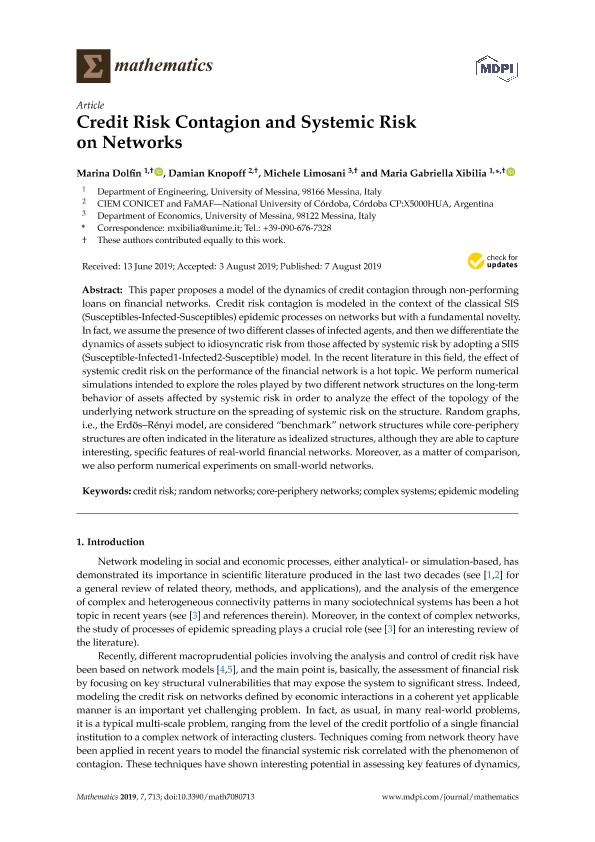Mostrar el registro sencillo del ítem
dc.contributor.author
Dolfin, Marina
dc.contributor.author
Knopoff, Damián Alejandro

dc.contributor.author
Limosani, Michele
dc.contributor.author
Xibilia, Maria Gabriella
dc.date.available
2021-02-03T19:53:46Z
dc.date.issued
2019-08-07
dc.identifier.citation
Dolfin, Marina; Knopoff, Damián Alejandro; Limosani, Michele; Xibilia, Maria Gabriella; Credit risk contagion and systemic risk on networks; MDPI AG; Mathematics; 7; 8; 7-8-2019; 713
dc.identifier.issn
2227-7390
dc.identifier.uri
http://hdl.handle.net/11336/124666
dc.description.abstract
This paper proposes a model of the dynamics of credit contagion through non-performing loans on financial networks. Credit risk contagion is modeled in the context of the classical SIS (Susceptibles-Infected-Susceptibles) epidemic processes on networks but with a fundamental novelty. In fact, we assume the presence of two different classes of infected agents, and then we differentiate the dynamics of assets subject to idiosyncratic risk from those affected by systemic risk by adopting a SIIS (Susceptible-Infected1-Infected2-Susceptible) model. In the recent literature in this field, the effect of systemic credit risk on the performance of the financial network is a hot topic. We perform numerical simulations intended to explore the roles played by two different network structures on the long-term behavior of assets affected by systemic risk in order to analyze the effect of the topology of the underlying network structure on the spreading of systemic risk on the structure. Random graphs, i.e., the Erdös-Rényi model, are considered "benchmark" network structures while core-periphery structures are often indicated in the literature as idealized structures, although they are able to capture interesting, specific features of real-world financial networks. Moreover, as a matter of comparison, we also perform numerical experiments on small-world networks.
dc.format
application/pdf
dc.language.iso
eng
dc.publisher
MDPI AG
dc.rights
info:eu-repo/semantics/openAccess
dc.rights.uri
https://creativecommons.org/licenses/by-nc-sa/2.5/ar/
dc.subject
COMPLEX SYSTEMS
dc.subject
CORE-PERIPHERY NETWORKS
dc.subject
CREDIT RISK
dc.subject
EPIDEMICMODELING
dc.subject
RANDOMNETWORKS
dc.subject.classification
Matemática Aplicada

dc.subject.classification
Matemáticas

dc.subject.classification
CIENCIAS NATURALES Y EXACTAS

dc.subject.classification
Economía, Econometría

dc.subject.classification
Economía y Negocios

dc.subject.classification
CIENCIAS SOCIALES

dc.title
Credit risk contagion and systemic risk on networks
dc.type
info:eu-repo/semantics/article
dc.type
info:ar-repo/semantics/artículo
dc.type
info:eu-repo/semantics/publishedVersion
dc.date.updated
2020-11-19T21:17:35Z
dc.journal.volume
7
dc.journal.number
8
dc.journal.pagination
713
dc.journal.pais
Suiza

dc.description.fil
Fil: Dolfin, Marina. University Of Messina. Department of Engineering; Italia
dc.description.fil
Fil: Knopoff, Damián Alejandro. Consejo Nacional de Investigaciones Científicas y Técnicas. Centro Científico Tecnológico Conicet - Córdoba. Centro de Investigación y Estudios de Matemática. Universidad Nacional de Córdoba. Centro de Investigación y Estudios de Matemática; Argentina. Universidad Nacional de Córdoba. Facultad de Matemática, Astronomía y Física; Argentina
dc.description.fil
Fil: Limosani, Michele. University Of Messina. Department Of Economics; Italia
dc.description.fil
Fil: Xibilia, Maria Gabriella. University Of Messina. Department Of Engineering; Italia
dc.journal.title
Mathematics
dc.relation.alternativeid
info:eu-repo/semantics/altIdentifier/doi/http://dx.doi.org/10.3390/math7080713
dc.relation.alternativeid
info:eu-repo/semantics/altIdentifier/url/https://www.mdpi.com/2227-7390/7/8/713
Archivos asociados
